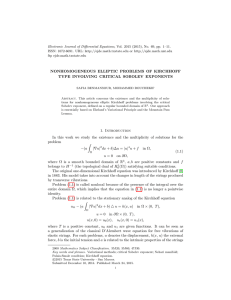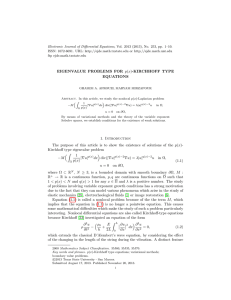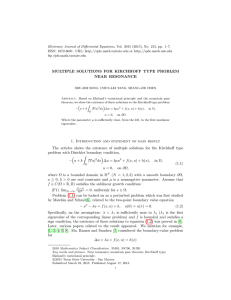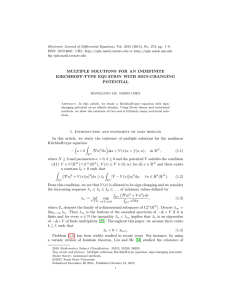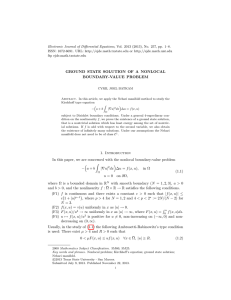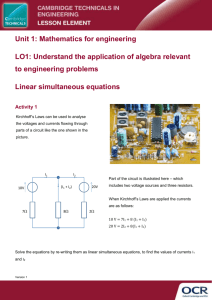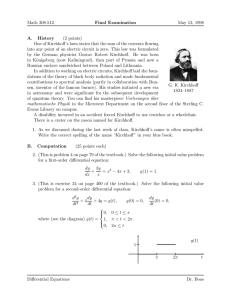Electronic Journal of Differential Equations, Vol. 2015 (2015), No. 316,... ISSN: 1072-6691. URL: or
advertisement
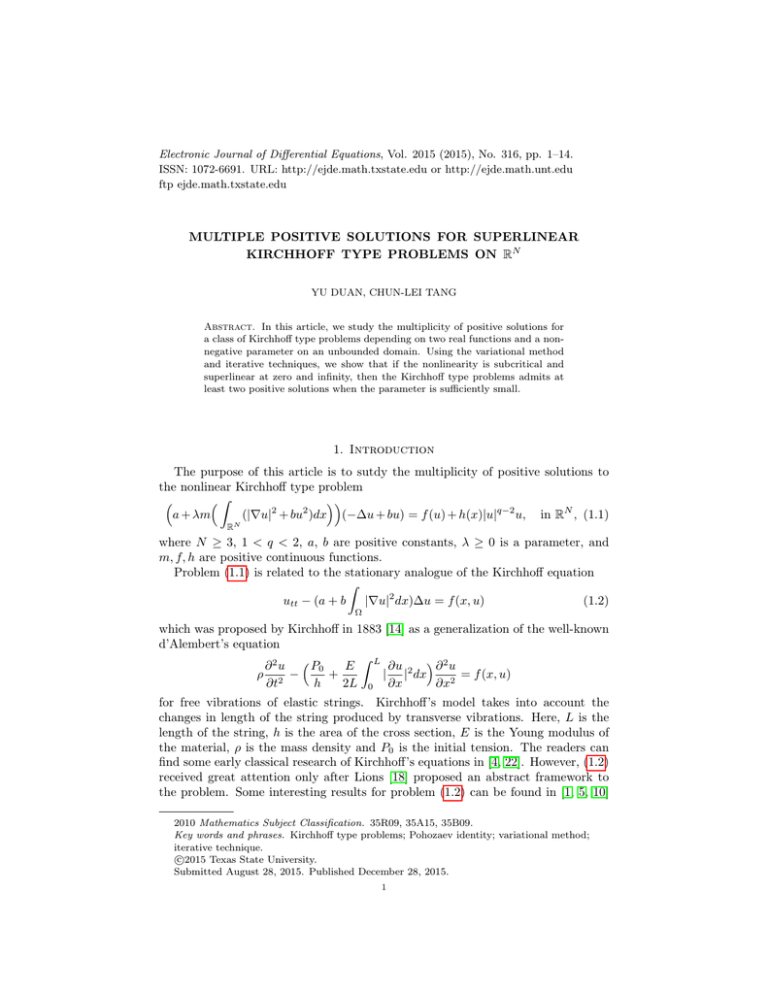
Electronic Journal of Differential Equations, Vol. 2015 (2015), No. 316, pp. 1–14.
ISSN: 1072-6691. URL: http://ejde.math.txstate.edu or http://ejde.math.unt.edu
ftp ejde.math.txstate.edu
MULTIPLE POSITIVE SOLUTIONS FOR SUPERLINEAR
KIRCHHOFF TYPE PROBLEMS ON RN
YU DUAN, CHUN-LEI TANG
Abstract. In this article, we study the multiplicity of positive solutions for
a class of Kirchhoff type problems depending on two real functions and a nonnegative parameter on an unbounded domain. Using the variational method
and iterative techniques, we show that if the nonlinearity is subcritical and
superlinear at zero and infinity, then the Kirchhoff type problems admits at
least two positive solutions when the parameter is sufficiently small.
1. Introduction
The purpose of this article is to sutdy the multiplicity of positive solutions to
the nonlinear Kirchhoff type problem
Z
(|∇u|2 + bu2 )dx (−∆u + bu) = f (u) + h(x)|u|q−2 u, in RN , (1.1)
a + λm
RN
where N ≥ 3, 1 < q < 2, a, b are positive constants, λ ≥ 0 is a parameter, and
m, f, h are positive continuous functions.
Problem (1.1) is related to the stationary analogue of the Kirchhoff equation
Z
utt − (a + b
|∇u|2 dx)∆u = f (x, u)
(1.2)
Ω
which was proposed by Kirchhoff in 1883 [14] as a generalization of the well-known
d’Alembert’s equation
Z L
∂2u
∂ 2 u P0
E
∂u
ρ 2 −
+
| |2 dx
= f (x, u)
∂t
h
2L 0 ∂x
∂x2
for free vibrations of elastic strings. Kirchhoff’s model takes into account the
changes in length of the string produced by transverse vibrations. Here, L is the
length of the string, h is the area of the cross section, E is the Young modulus of
the material, ρ is the mass density and P0 is the initial tension. The readers can
find some early classical research of Kirchhoff’s equations in [4, 22]. However, (1.2)
received great attention only after Lions [18] proposed an abstract framework to
the problem. Some interesting results for problem (1.2) can be found in [1, 5, 10]
2010 Mathematics Subject Classification. 35R09, 35A15, 35B09.
Key words and phrases. Kirchhoff type problems; Pohozaev identity; variational method;
iterative technique.
c
2015
Texas State University.
Submitted August 28, 2015. Published December 28, 2015.
1
2
Y. DUAN, C.-L. TANG
EJDE-2015/316
and the references therein. More recently some mathematicians study the following
Kirchhoff type problems on bounded domain
Z
− a+b
|∇u|2 dx ∆u = f (x, u), in Ω,
(1.3)
Ω
u = 0, on ∂Ω.
Some interesting studies for problem (1.3) by variational methods can be found in
[2, 9, 17, 20, 21, 24, 28, 29] and the references therein. Especially, the authors [28]
studied the existence of positive solution for Kirchhoff type problem on bounded
domain using iterative techniques and variational methods.
Recently, authors have studied widely Kirchhoff type problems under various
conditions on f and V on the whole space RN :
Z
a+λ
(|∇u|2 + V (x)u2 )dx
− ∆u + V (x)u = f (x, u), in RN . (1.4)
RN
When f (x, u) = |u|p−2 u, p ∈ (2, 2∗ ), Huang and Liu [12] considered (1.4) and studied existence and nonexistence of positive solution by variational methods; they
also discussed the energy doubling property of nodal solutions by Nehari manifold.
The results in [12] complement the corresponding results in [15, 16]. Li and Ye [15]
showed that (1.4) has no nontrivial solution provided f (x, u) = |u|p−2 u, p ∈ (2, 3)
when λ > 0 is sufficiently large. If V (x) = b and f (x, u) = f (u) is superlinear at
infinity, Li, Li and Shi [16] showed that (1.4) has at least one positive radial solution
for λ > 0 sufficiently small. Wu, Huang and Liu [26] gave a total description on
the positive solutions to (1.4), and they made an observation on the sign-changing
solutions. When f (x, u) is asymptotically linear with respect to u at infinity, Ye
and Yin [27] studied (1.4) and proved the existence of positive solution for λ sufficiently small and the nonexistence result for λ sufficiently large. Very recently,
some authors extend the problem (1.4) to the p-Kirchhoff elliptic equations, see e.g.
[6, 7, 8, 19] and the references therein.
In the spirit of [16, 28], for any continuous function m, we establish a multiplicity
criterion of positive radial solutions to (1.1) using a variational method and an
iterative technique. The main result of this article reads as follows.
Theorem 1.1. Assume that N ≥ 3, and a, b are positive constants, λ ≥ 0 is a
parameter and the following conditions hold:
(H1) f ∈ C(R+ , R+ ) and there are positive constants c and p ∈ (2, 2∗ ) such that
f (t) ≤ c(1 + tp−1 ) for t ≥ 0, where 2∗ = N2N
−2 for N ≥ 3;
(H2) limt→0 f (t)
t = 0;
(H3) limt→∞ f (t)
t = ∞;
0
0
(H4) 0 ≤ h(x) = h(|x|) ∈ Lq (RN ), h∇h(x), xi ∈ Lq (RN ), where q 0 =
denotes the usual inner product in RN and 1 < q < 2.
2∗
2∗ −q ,
h·, ·i
Then for any positive continuous function m, there exist two constants λ̃ > 0 and
m0 > 0 such that for any λ ∈ [0, λ̃), problem (1.1) has at least two positive solutions
if khkq0 < m0 .
Since the result in Theorem 1.1 holds for m(t) = t, our result generalizes [16,
Theorem 1.1]. In this paper, we give multiplicity results for the positive solutions
of (1.1), while the authors [16] only studied the existence of positive solutions.
EJDE-2015/316
MULTIPLE POSITIVE SOLUTIONS
3
Furthermore, our method is different from that used in [16], we combine variational
methods and iterative technique.
Our result can be regarded as an extension of the bounded case considered in
[28] to the unbounded case. Also we give two positive solutions, while the authors
[28] only studied the existence of positive solutions.
This article is organized as follows: In Section 2, we give some preliminaries. In
Section 3 and 4 we present the proofs of the main results. Through out this paper,
C, Ci are used in various places to denote distinct constants.
2. Preliminaries
1
N
Let H (R ) be the usual Sobolev space equipped with the inner product and
norm
Z
1
hu, vi =
(∇u · ∇v + buv)dx, kuk = hu, ui 2 .
RN
We denote by k · kp the usual Lp (RN ) norm. We only consider positive solutions to
(1.1), and we assume that f (t) = 0 for t < 0
To obtain our result, we have to overcome various difficulties. On one hand, it
is well known that Sobolev embedding H 1 (RN ) ,→ Lp (RN ) is continuous but not
compact for p ∈ [2, 2∗ ], and then it is usually difficult to prove that a minimizing
sequence or a Palais-Smale sequence is strongly convergent if we seek solutions
of (1.1) by variational methods. To overcome this difficulty, we usually restrict
problem (1.1) in the radial function space. Let H = Hr1 (RN ) be the subspace
of H 1 (RN ) containing only the radial functions. We recall [25], H ,→ Lp (RN )
compactly (continuously) for p ∈ (2, 2∗ )(p ∈ [2, 2∗ ]). That is, there exists a γp > 0
such that kukp ≤ γp kuk, p ∈ [2, 2∗ ]. On the other hand, the nonlinearity f may not
satisfy (AR) or 4-superlinearity, it is difficult to get the boundedness of any (PS)
sequence even if a (PS) sequence has been obtained. To overcome this difficulty,
we use a “freezing” technique whose formulation appears initially in [11]. This
technique will help us to change problem (1.1) into semilinear equation. That is,
for each fixed ω ∈ H, we consider the “freezing” problem given by
Z
a + λm
(|∇ω|2 + bω 2 )dx
− ∆u + bu = f (u) + h(x)|u|q−2 u, in RN ,
RN
and the associated function Jω : H → R is defined by
Z
Z
1
1
Jω (u) = a + λm(kωk2 ) kuk2 −
F (u)dx −
h(x)|u|q dx, u ∈ H,
2
q
N
N
R
R
Rt
where F (t) = 0 f (s)ds. Clearly, by the assumptions imposed on f , h and m, we
know that Jω (u) is well defined on H, it is of class C 1 for all λ ≥ 0, and
Z
Z
hJω0 (u), vi = a + λm(kωk2 )
(∇u · ∇v + buv)dx −
f (u)v dx
RN
RN
Z
−
h(x)|u|q−2 uv dx, u, v ∈ H.
RN
Next we recall a monotonicity method by Jeanjean [13] and Struwe [23], which
will be used in our proof. The version here is from [13].
4
Y. DUAN, C.-L. TANG
EJDE-2015/316
Theorem 2.1. Let (X, k · k) be a Banach space and I ⊂ R+ an interval. Consider
the family of C 1 functionals on X
Jµ (u) = A(u) − µB(u),
µ ∈ I,
with B nonnegative and either A(u) → ∞ or B(u) → ∞ as kuk → ∞ and such
that Jµ (0) = 0. For any µ ∈ I, we set
Γµ = γ ∈ C([0, 1], X) : γ(0) = 0, Jµ (γ(1)) < 0 .
If for every µ ∈ I, the set Γµ is nonempty and
cµ = inf max Jµ (γ(t)) > 0,
γ∈Γµ t∈[0,1]
then for almost every µ ∈ I, there exists a sequence {un } ⊂ X such that
(i) {un } is bounded;
(ii) Jµ (un ) → cµ as n → ∞;
(iii) Jµ0 (un ) → 0 as n → ∞, in the dual space X −1 of X.
3. First positive solution of (1.1)
In this section, we use Theorem 2.1 to obtain the first positive solution for (1.1).
In the setting of Theorem 2.1, we have X = H, I = [1/2, 1], and for each fixed
ω ∈ H,
Z
Z
1
1
a + λm(kωk2 ) kuk2 −
h(x)(u+ )q dx, B(u) =
F (u)dx,
Aω (u) =
2
q RN
RN
where u+ = max{u, 0}. So the perturbed functional that we study is
Z
Z
1
1
Iω,τ (u) =
a + λm(kωk2 ) kuk2 −
h(x)(u+ )q dx − τ
F (u)dx,
2
q RN
RN
It follows from (H4) that
Z
1
1
a
a + λm(kωk2 ) kuk2 −
h(x)(u+ )q dx ≥ kuk2 −
2
q RN
2
a
≥ kuk2 −
2
τ ∈ I.
1
khkq0 kukq2∗
q
γ2q∗
khkq0 kukq ,
q
which implies that Aω (u) → ∞ as kuk → ∞ and obviously, B(u) ≥ 0. Next, we
give some lemmas that are important for proving our main result.
Lemma 3.1. For each ω ∈ H and τ ∈ I, each bounded (PS) sequence of the
functional Iω,τ in H admits a convergent subsequence.
Proof. For each given ω ∈ H and τ ∈ I, let {un } be a bounded (PS) sequence of
the functional Iω,τ , namely {un } and {Iω,τ (un )} are bounded, and
0
Iω,τ
(un ) → 0
in H −1 ,
where H −1 is the dual space of H. Since {un } is bounded, subject to a subsequence,
we can assume that there exists u ∈ H such that as n → ∞,
un * u, in H;
2N
un → u, in Ls (RN ) (2 < s <
);
(3.1)
N −2
un → u, a.e x ∈ RN .
EJDE-2015/316
MULTIPLE POSITIVE SOLUTIONS
5
By (H1) and (H2), for any ε > 0, there exists C > 0 such that
|f (t)| ≤ bε|t| + Cε |t|p−1 ,
t ∈ R.
(3.2)
It follows from (3.2), the Hölder inequality, the Sobolev inequality and the boundedness of {un } that
Z
Z
|f (un )(un − u)| dx
f (un )(un − u)dx ≤
RN
RN
Z
Z
≤ bε
|un ||un − u|dx + Cε
|un |p−1 |un − u|dx
RN
≤
≤
RN
bεkun k2 kun − uk2 + Cε kun kpp−1 kun − ukp
εCkun kkun − uk + Cε Ckun kp−1 kun − ukp
≤ εC + Cε Ckun − ukp .
Then, by (3.1) we can obtain
lim sup n→∞
Z
f (un )(un − u)dx ≤ εC.
(3.3)
RN
Therefore, using the arbitrariness of ε in (3.3), we have
Z
f (un )(un − u)dx → 0, as n → ∞.
(3.4)
RN
Using (3.1), we have
q−1
(u+
(un − u) → 0,
n)
Since
Z
RN
2∗ /q
q−1
u+
(un − u)
dx ≤
n)
Z
RN
a.e. x ∈ RN .
Z
q−1
q
2∗
(u+
)
dx
n
≤ Ckun k
1/q
RN
(q−1)2∗
q
2∗
≤ kun k
∗
(un − u)2 dx
∗
2 /q
kun − uk2∗
(q−1)2∗
q
∗
kun − uk2
/q
< +∞.
∗
q−1
(un − u) is bounded in L2 /q (RN ). Hence, going if necessary to a
So, (u+
n)
∗
q−1
subsequence, we can assume that (u+
(un − u) * 0 in L2 /q (RN ) and using
n)
(H4),
Z
RN
q−1
h(x)(u+
(un − u)dx → 0,
n)
as n → ∞.
(3.5)
0
Thus, by using (3.4), (3.5) and Iω,τ
(un ) → 0, we have
Z
0
a + λm(kωk2 ) hun , un − ui = hIω,τ
(un ), un − ui + τ
f (un )(un − u)dx
RN
Z
q−1
+
h(x)(u+
(un − u)dx → 0;
n)
RN
that is, kun k → kuk. This together with un * u shows that un → u in H.
Lemma 3.2. For each R > 0 and ω ∈ H with kωk ≤ R, there exists λ̃ = λ̃(R) > 0,
m0 > 0 and τk ⊂ [1/2, 1] satisfying that τk → 1 as k → ∞, such that Iω,τk has a
nontrivial critical point uω,τk if λ ∈ [0, λ̃), khkq0 < m0 .
6
Y. DUAN, C.-L. TANG
EJDE-2015/316
Proof. We choose a function φ ∈ C0∞ (RN ) with φ ≥ 0, kφk = 1 and supp(φ) ⊂
B(0, R0 ) for some R0 > 0. For given constant R > 0, there exists λ̃ = λ̃(R) > 0,
such that if λ ∈ [0, λ̃), we have λ maxξ∈[0,R2 ] m(ξ) ≤ 1. By (H3), for R 2(a+1)
>
φ2 dx
B(0,R0 )
0, there exists C1 > 0 such that
2(a + 1)
t2 − C1 ,
2 dx
φ
B(0,R0 )
F (t) ≥ R
t ≥ 0.
So, for t ≥ 0 we get
Z
Z
t2
tq
a + λm(kωk2 ) kφk2 − τ
h(x)φq dx
F (tφ)dx −
2
q
N
N
R
R
Z
Z
t2 2(a + 1)
tq
t2
2
2
a + λm(kωk ) − R
φ
dx
−
h(x)φq dx
≤
2
2 B(0,R0 ) φ2 dx B(0,R0 )
q RN
Iω,τ (tφ) =
C1 |B(0, R0 )|
2
Z
t2
C1 |B(0, R0 )| tq
≤ − (a + 1) +
−
h(x)φq dx.
2
2
q RN
+
(3.6)
On one hand, by (H4), we can obtain
C1 |B(0, R0 )| tq
t2
−
Iω,τ (tφ) ≤ − (a + 1) +
2
2
q
Z
h(x)φq dx → −∞,
t → +∞;
RN
on the other hand, by (3.6), we known that there exists a constant C = C(R0 ) > 0
(depending on ω and τ ) such that
max Iω,τ (tφ) ≤
t≥0
C1 |B(0, R0 )|
:= C.
2
(3.7)
Hence, we can choose t > 0 large enough such that Iω,τ (tφ) < 0; that is, Γω,τ 6= ∅,
where, Γω,τ = {γ ∈ C([0, 1], H) : γ(0) = 0, Iω,τ (γ(1)) < 0}.
Using (H1) and (H2), for ε ∈ (0, a2 ), there exists C2 () > 0 such that
ε
F (t) ≤ bt2 + C2 (ε)tp , t ≥ 0.
2
By Sobolev’s embedding theorem, there exists C3 (ε) > 0 such that
Z
Z
1
1
Iω,τ (u) =
a + λm(kωk2 ) kuk2 − τ
F (u)dx −
h(x)(u+ )q dx
2
q RN
RN
Z
Z
a
ε
1
2
2
≥ kuk − b
u dx − C2 (ε)
|u|p dx − khkq0 kukq2∗
2
2 RN
q
RN
q
a
γ∗
≥ kuk2 − C3 (ε)kukp − 2 khkq0 kukq
4
q
a
γ q∗
≥ kukq kuk2−q − C3 (ε)kukp−q − 2 khkq0 .
4
q
Setting
a 2−q
t
− C3 (ε)tp−q
4
for t ≥ 0. Since 1 < q < 2 < p < 2∗ , we can choose a constant ρ > 0 sufficiently
small such that g(ρ) > 0. Taking m0 := 2γqq∗ g(ρ), it then follows that there exists
g(t) =
2
EJDE-2015/316
MULTIPLE POSITIVE SOLUTIONS
7
a constant c := 21 g(ρ)ρq > 0 which is independent of τ , λ and ω such that
Iω,τ (u)kuk=ρ ≥ c > 0,
for any τ ∈ I, ω ∈ H and all h satisfying khkq0 < m0 . Fix τ ∈ I and for any
γ ∈ Γω,τ , by the definition of Γω,τ , we have kγ(1)k > ρ. Since γ(0) = 0, then
from intermediate value theorem, we deduce that there exists tγ ∈ (0, 1) such that
kγ(tγ )k = ρ. Therefore, for any fixed τ ∈ I,
max Iω,τ (γ(t)) ≥ inf Iω,τ (γ(tγ )) ≥ c > 0.
cω,τ = inf
γ∈Γω,τ t∈[0,1]
γ∈Γω,τ
Following Theorem 2.1, there are {τk } ⊂ [1/2, 1), with τk → 1 as k → ∞, and
for every k, there exists a sequence {un,ω,τk } ⊂ H, such that {un,ω,τk } is bounded
0
and Iω,τk (un,ω,τk ) → cω,τk , Iω,τ
(un,ω,τk ) → 0, where
k
cω,τk =
inf
sup
γ∈Γω,τk u∈γ([0,1])
Iω,τk (u),
Γω,τk = γ ∈ C([0, 1], H)|γ(0) = 0, Iω,τk (γ(1)) < 0 .
Furthermore, by Lemma 3.1, we can suppose that there exists uω,τk ∈ H such that
un,ω,τk → uω,τk , and then
Iω,τk (uω,τk ) = cω,τk ,
0
Iω,τ
(uω,τk ) = 0.
k
From the above discussion, we get that for given R > 0 and ω ∈ H with kωk ≤ R,
there exists λ̃ = λ̃(R) > 0, m0 > 0 and τk ⊂ [ 21 , 1] satisfying that τk → 1 as k → ∞,
such that Iω,τk has a nontrivial critical point uω,τk if λ ∈ [0, λ̃), khkq0 < m0 and
cω,τk = Iω,τk (uω,τk ) ≤ max Iω,τk (tφ) ≤ C,
t≥0
(3.8)
where C is given in (3.7).
Lemma 3.3. Let uω,τk be a critical point of Iω,τk at level cω,τk . Then {uω,τk } are
uniformly bounded.
Proof. It follows from Lemma 3.2 that uω,τk is a weak solution of the problem
a + λm(kωk2 ) (−∆u + bu) = τk f (u) + h(x)(u+ )q−1 ;
therefore,
q−1
a + λm(kωk2 ) (−∆uω,τk + buω,τk ) = τk f (uω,τk ) + h(x)(u+
.
ω,τk )
Hence, we have the following Pohozaev identity
Z
N − 2 Z
Nb
2
|∇uω,τk | dx +
u2ω,τk dx a + λm(kωk2 )
2
2 RN
N
ZR
Z 1
q
= N τk
F (uω,τk )dx +
N h + h∇h(x), xi (u+
ω,τk ) dx .
q RN
RN
The proof is similar to that of [3, Proposition 1], we omit here.
By letting cω,τk = Iω,τk (uω,τk ), we have
Z
1
cω,τk =
a + λm(kωk2 ) kuω,τk k2 − τk
F (uω,τk )dx
2
RN
Z
1
q
−
h(x)(u+
ω,τk ) dx.
q RN
(3.9)
(3.10)
(3.11)
8
Y. DUAN, C.-L. TANG
EJDE-2015/316
By (H4) and the Hölder inequality, we deduce that
Z
1Z 1 +
q
q
h∇h(x), xi(u+
h∇h(x), xi(uω,τk ) dx ≤
ω,τk ) dx
q RN
q RN
1
q
≤ kh∇h(x), xikq0 k(u+
ω,τk )k2∗
q
Z
q/2
≤ C4
|∇uω,τk |2 dx
.
(3.12)
RN
Therefore, by (3.8) and (3.10)-(3.12), we obtain
R
Z
q
N cω,τk − 1q RN h∇h(x), xi(u+
ω,τk ) dx
2
|∇uω,τk | dx =
a + λm(kωk2 )
RN
q/2
R
N cω,τk + C4 RN |∇uω,τk |2 dx
≤
a + λm(kωk2 )
q/2
R
N C + C4 RN |∇uω,τk |2 dx
≤
.
a
R
Because of 1 < q < 2, RN |∇uω,τk |2 dx is uniformly bounded. That is, there exists
a constant C5 > 0, independent of τ , λ and ω, such that
Z
|∇uω,τk |2 dx ≤ C5 .
(3.13)
RN
Furthermore, by (H1) and (H2), there exists a constant C6 > 0 such that
∗
ab
|t| + C6 |t|2 −1 , t ∈ R.
(3.14)
2
Hence, by (3.9) and (3.14), we have
a + λm(kωk2 ) kuω,τk k2
Z
Z
q
= τk
f (uω,τk )uω,τk dx +
h(x)(u+
ω,τk ) dx
N
N
ZR
Z R
Z
q/2∗
∗
∗
ab
2
|uω,τk | dx + C6
|uω,τk |2 dx + khkq0
|uω,τk |2 dx
≤
2 RN
RN
RN
Z
Z
q/2∗
∗
∗
a
≤ kuω,τk k2 + C6
|uω,τk |2 dx + khkq0
|uω,τk |2 dx
.
2
RN
RN
|f (t)| ≤
Using (3.13), we conclude that
Z
Z
q/2∗
∗
∗
a
kuω,τk k2 ≤ C6
|uω,τk |2 dx + khkq0
|uω,τk |2 dx
2
RN
RN
Z
2∗ /2
Z
q/2
≤ C7
|∇uω,τk |2 dx
+ C8
|∇uω,τk |2 dx
≤
RN
2∗ /2
C7 C5
RN
+
q/2
C8 C5 .
2∗ /2
q/2
Then kuω,τk k2 ≤ C9 , where C9 = a2 C7 C5
+ a2 C8 C5 which is independent of τ ,
√
λ and ω. If we set R = C9 , then for any ω ∈ H with kωk ≤ R, there exist λ̃ > 0
m0 > 0 which are independent of τ , λ and ω, such that Iω,τk has a nontrivial critical
point uω,τk with kuω,τk k ≤ R when λ ∈ [0, λ̃), khk2 < m0 . And also, {uω,τk } is
uniformly bounded.
EJDE-2015/316
MULTIPLE POSITIVE SOLUTIONS
9
√
Now we choose R = C9 as above and construct a family of sequence by iterative
techniques. For every k, if we let ω = ω0 ≡ 0, by the previous arguments, we know
Iω0 ,τk has a nontrivial critical point and denote it by u1,k with ku1,k k ≤ R. Let
ω = u1,k , then Iu1,k ,τk has a nontrivial critical point and denote it by u2,k with
ku2,k k ≤ R. Hence, by induction, we can get a sequence {un,k } with kun,k k ≤ R,
n = 1, 2, . . . , such that Iu0 n,k ,τk (un+1,k ) · v = 0 for all v ∈ H.
Existence of the first positive solution to (1.1). To complete the proof, we
proceed in two steps.
Step 1. For any fixed k, the iterative sequence {un,k } constructed in Lemma 3.3
is convergent to a function uk , which is a critical point of Iuk ,τk .
Since for fixed k and for all n ∈ N, kun,k k ≤ R, if necessary going to a subsequence, we suppose that there exists uk ∈ H such that as n → ∞,
un,k * uk ,
un,k → uk ,
in H;
in Lp (RN )(2 < p < 2∗ );
un,k → uk ,
(3.15)
N
a.e. x ∈ R .
Also we have kuk k ≤ R, for all k ∈ N. From the subcritical growth of f and (3.15),
we see that
Z
f (un,k ) − f (uk ) (un,k − uk )dx → 0, as n → ∞;
(3.16)
RN
Z
q−1
q−1
h(x)(u+
− h(x)(u+
(un,k − uk )dx → 0, as n → ∞.
(3.17)
n,k )
k)
RN
The proof is similar to that of (3.4) and (3.5), and we omit here. Then we have
a + λm(kun−1,k k2 ) kun,k − uk k2
D
E
= Iu0 n−1,k ,τk (un,k ) − Iu0 n−1,k ,τk (uk ), un,k − uk
Z + τk
f (un,k ) − f (uk ) (un,k − uk )dx
N
Z R
q−1
q−1
+
h(x)(u+
− h(x)(u+
(un,k − uk )dx → 0 as n → ∞;
n,k )
k)
RN
that is, un,k → uk in H as n → ∞. Thus, for any v ∈ H, as n → ∞, we have
a + λm(kun−1,k k2 ) → a + λm(kuk k2 ),
Z
(∇un,k · ∇v + bun,k v) dx →
(∇uk · ∇v + buk v) dx,
RN
Z
Z
τk
f (un,k )v dx → τk
f (uk )v dx,
RN
RN
Z
Z
τk
F (un,k )dx → τk
F (uk )dx.
Z
RN
RN
RN
Also, we have
Z
Z
RN
Z
q−1
q−1
h(x)(u+
)
v
dx
→
h(x)(u+
v dx,
n,k
k)
RN
RN
Z
q
q
h(x)(u+
h(x)(u+
as n → ∞,
n,k ) dx →
k ) dx,
RN
10
Y. DUAN, C.-L. TANG
EJDE-2015/316
the proof is similar to that of (3.5), and we omit here. So, we obtain
Iu0 k ,τk (uk ) · v = lim Iu0 n−1,k ,τk (un,k ) · v = 0,
n→∞
Iuk ,τk (uk ) = lim Iun−1,k ,τk (un,k ) = lim cun−1,k ,τk ≥ c > 0;
n→∞
n→∞
that is, for any v ∈ H,
Iu0 k ,τk (uk ) · v = 0,
Iuk ,τk (uk ) ≥ c > 0.
Step 2. The sequence {uk } obtained in step 1 is convergent to a nontrivial positive
solution of (1.1).
Since kuk k ≤ R for all k ∈ N, without loss of generality, we can assume that
there exists a function u ∈ H such that
uk * u, in H;
uk → u,
in Lp (RN )(2 < p < 2∗ );
uk → u,
(3.18)
N
a.e. x ∈ R .
By the similar proof to that of (3.16) and (3.17), we have
Z
f (uk ) − f (u) (uk − u)dx = o(1),
N
R
Z
q−1
h(x)(u+
− h(x)(u+ )q−1 (uk − u)dx = o(1).
k)
RN
Now, taking into account that
a + λm(kuk k2 ) kuk − uk2
Z = hIu0 k ,τk (uk ) − Iu0 k ,τk (u), uk − ui + τk
f (uk ) − f (u) (uk − u)dx
RN
Z q−1
+
h(x)(u+
− h(x)(u+ )q−1 (uk − u)dx → 0 as n → ∞,
k)
RN
we deduce that uk → u as k → ∞. So for any v ∈ H, as k → ∞, we have
a + λm(kuk k2 ) → a + λm(kuk2 ),
Z
(∇uk · ∇v + buk v)dx →
(∇u · ∇v + buv)dx,
N
RN
Z
ZR
τk
f (uk )v dx →
f (u)v dx,
RN
RN
Z
Z
τk
F (uk )dx →
F (u)dx,
N
RN
Z
Z R
q−1
h(x)(u+
v dx →
h(x)(u+ )q−1 v dx,
k)
RN
RN
Z
Z
q
h(x)(u+
)
dx
→
h(x)(u+ )q dx.
k
Z
RN
RN
So, for any v ∈ H, as k → ∞, we can obtain
Z
Z
2
a + λm(kuk )
∇u · ∇v + buv dx −
RN
= lim Iu0 k ,τk (uk ) · v = 0,
k→∞
RN
Z
f (u)v dx −
RN
h(x)(u+ )q−1 v dx
EJDE-2015/316
MULTIPLE POSITIVE SOLUTIONS
11
and
Z
Z
Z
1
2
2
2
a + λm(kuk )
|∇u| + bu dx −
F (u)dx −
h(x)(u+ )q dx
2
RN
RN
RN
= lim Iuk ,τk (uk ) = cuk ,τk ≥ c > 0.
n→∞
Therefore, u is a nontrivial solution of (1.1). Setting u− = max{−u, 0}, Since
Z
Z
(a + λm(kuk2 ))hu, u− i −
f (u)u− dx −
h(x)(u+ )q−1 u− dx = 0,
RN
RN
−
by (H1) and (H4) we have ku k = 0; this implies u ≥ 0 a.e. in RN . So, by the
strong maximum principle, we get that u is positive on H. Thus u is a positive
solution of (1.1) if λ ∈ [0, λ̃), khkq0 < m0 .
4. Second positive solution of (1.1)
In this section, we prove the existence of local minimum solution for problem
(1.1) by Ekeland’s variational principle. Define the functional I : H → R by
Z
Z
λ
1
a
2
2
F (u)dx −
h(x)(u+ )q dx,
Iλ (u) = kuk + M (kuk ) −
2
2
q RN
RN
Rt
where M (t) = 0 m(s)ds. Then, it follows from (H1)–(H4) and the continuity of m
that Iλ is well defined on H and is C 1 for all λ ≥ 0, and
Z
hIλ0 (u), vi = (a + λm(kuk2 ))
(∇u · ∇v + buv)dx
RN
Z
Z
−
f (u)v dx −
h(x)(u+ )q−1 v dx, u, v ∈ H.
RN
RN
Lemma 4.1. Assume that (H1), (H2), (H4) are satisfied. Then there exist constants ρ, m0 , α > 0 such that Iλ (u)kuk=ρ ≥ α > 0 with khk2 < m0 .
Proof. Using (H1) and (H2), for ε ∈ (0, a2 ), there exists C12 () > 0 such that
ε
F (t) ≤ bt2 + C12 (ε)tp , t ≥ 0.
2
By Sobolev’s embedding theorem, there exists C13 (ε) > 0 such that
Z
Z
λ
1
a
Iλ (u) = kuk2 + M (kuk2 ) −
F (u)dx −
h(x)(u+ )q dx
2
2
q RN
RN
Z
Z
a
ε
1
2
2
≥ kuk − b
u dx − C12 (ε)
|u|p dx − khkq0 kukq2∗
2
12 RN
q
N
R
∗
a
γ
2
≥ kuk2 − C13 (ε)kukp −
khkq0 kukq
4
q
a
γ2∗
≥ kukq kuk2−q − C13 (ε)kukp−q −
khkq0
4
q
So, setting
a
g(t) = t2−q − C13 (ε)tp−q
4
for t ≥ 0. Since 1 < q < 2 < p < 2∗ , we can choose a constant ρ > 0 sufficiently
small such that g(ρ) > 0. Taking m0 := 2γq2∗ g(ρ), it then follows that there exists
a constant α := 12 g(ρ)ρq > 0 which is independent of τ , λ and ω such that
Iλ (u)
≥ α > 0,
kuk=ρ
12
Y. DUAN, C.-L. TANG
EJDE-2015/316
for any τ ∈ I, ω ∈ H and all h satisfying khkq0 < m0 .
Lemma 4.2. Assume that (H1)-(H4) are satisfied, then there exist a function e ∈ H
e such that Iλ (e) < 0 for any λ ∈ [0, λ∗ ),
with kek < ρ and a constant 0 < λ∗ < λ
e are given by Lemma 4.1 and Lemma 3.2, respectively.
where ρ and λ
R
Proof. We choose a function 0 ≤ φ ∈ C0∞ (RN ) with B(0,R0 ) h(x)φq dx ≥ 0 for some
R0 > 0. By (H1), for t ≥ 0 we obtain
Z
Z
at2
tq
2
I0 (tφ) =
h(x)φq dx
kφk −
F (tφ)dx −
2
q RN
RN
Z
(4.1)
at2
tq
2
q
≤
kφk −
h(x)φ dx.
2
q B(0,R0 )
Since 1 < q < 2, it follows from (4.1) that I0 (tφ) < 0 for t > 0 sufficiently small,
which implies that there exist e ∈ H with kek < ρ such that I0 (e) < 0, where ρ
is given by Lemma 4.1. Since Iλ (e) → I0 (e) as λ → 0+ , we see that there exists
e > λ∗ > 0 such that Iλ (e) < 0 for all λ ∈ [0, λ∗ ), where λ
e is given by Lemma
λ
3.2.
Second positive solution for (1.1)
Setting
c1 := inf{Iλ (u) : u ∈ B ρ },
where ρ is given by Lemma 4.1, Bρ = {u ∈ H : kuk < ρ}. Using Lemma 4.1 and
Lemma 4.2, we obtain
inf Iλ > −∞,
Bρ
inf Iλ > α > 0,
∂Bρ
c1 < 0.
By Ekeland’s variational principle, there exists a sequence {un } ⊂ B ρ such that
c1 ≤ Iλ (un ) < c1 +
Iλ (v) ≥ Iλ (un ) −
1
,
n
1
kv − un k
n
for all v ∈ B ρ . Then by a standard procedure, we can show that {un } is a bounded
Palais-Smale sequence of Iλ . Using the similar proof to that of Lemma 3.1, we
conclude that there exists a function u1 ∈ Bρ such that Iλ (u1 ) = c1 < 0 and
Iλ0 (u1 ) = 0.
Setting u− = max{0, −u}. Since
Z
Z
−
q−1 −
a + λm(ku1 k2 ) hu1 , u−
i
−
f
(u
)u
dx
−
h(x)(u+
u1 dx = 0,
1
1
1
1)
RN
RN
ku−
1k
by (H1) and (H4) we have
= 0, which implies u1 ≥ 0 a.e. in RN . So, by the
strong maximum principle, we obtain that u1 is positive on H.
Acknowledgments. This research was supported by the National Natural Science Foundation of China (Nos. 11471267, 11361003), and by the Fundamental
Research Funds for the Central Universities (No. XDJK2013C006). The authors
want to express their gratitude to the reviewers for the careful reading and helpful
suggestions which led to an improvement of the original manuscript.
EJDE-2015/316
MULTIPLE POSITIVE SOLUTIONS
13
References
[1] A. Arosio, S. Panizzi; On the well-posedness of the Kirchhoff string, Trans. Amer. Math.
Soc., 348 (1996), 305–330.
[2] C. O. Alves, F. J. S .A. Corrêa, T. F. Ma; Positive solutions for a quasilinear elliptic equation
of Kirchhoff type, Comput. Math. Appl., 49 (2005), 85–93.
[3] H. Berestycki, P. L. Lions; Nonlinear scalar field equations. I. existence of a ground state
solutions, Arch. Ration. Mech. Anal., 82 (1983), 313–345.
[4] S. Bernstein; Sur une classe d’équations fonctionnelles aux dérivées partielles, Bull. Acad.
Sci. URSS. Sér. Math. [Izvestia Akad. Nauk SSSR], 4 (1940), 17–26.
[5] M. M. Cavalcanti, V. N. Domingos Cavalcanti, J. A. Soriano; Global existence and uniform
decay rates for the Kirchhoff-Carrier equation with nonlinear dissipation, Adv. Differential
Equations, 6 (2001), 701–730.
[6] C. S. Chen, Q. Yuan; Existence of solution to p-Kirchhoff type problem in RN via Nehari
manifold, Commun. Pure Appl. Anal., 13 (2014), 2289–2303.
[7] C. S. Chen, Q. Zhu; Existence of positive solutions to p-Kirchhoff-type problem without
compactness conditions, Appl. Math. Lett., 28 (2014), 82–87.
[8] X. Y. Chen, G. W. Dai; Positive solutions for p-Kirchhoff type problems on RN , Math.
Methods. Appl. Sci., 38 (2015), 2650–2662.
[9] B. T. Cheng; New existence and multiplicity of nontrivial solutions for nonlocal elliptic
Kirchhoff type problems, J. Math. Anal. Appl., 394 (2012), 488–495.
[10] P. D’Ancona, S. Spagnolo; Global solvability for the degenerate Kirchhoff equation with real
analytic data, Invent. Math., 108 (1992), 247–262.
[11] D. De. Figueiredo, M. Girardi, M. Matzeu; Semilinear elliptic equations with dependence on
the gradient via mountain pass technique, Differential Integral Equations, 17 (2004), 119–126.
[12] Y. S. Huang, Z. Liu; On a class of Kirchhoff type problems, Arch. Math., 102 (2014), 127–139.
[13] L. Jeanjean; Local conditions insuring bifurcation from the continuous spectrum, Math. Z.,
232 (1999), 651–664.
[14] G. Kirchhoff; Mechanik, Teubner, Leipzig, 1883.
[15] G. B. Li, H.Y. Ye; Existence of positive ground solutions for the nonlinear Kirchhoff type
equations in R3 , J. Differential Equations, 257 (2014), 566–600.
[16] Y. H. Li, F. Y. Li, J. P. Shi; Existence of a positive solution to Kirchhoff type problems
without compactness conditions, J. Differential Equations, 253 (2012), 2285–2294.
[17] Z. P. Liang, F. Y. Li, J. P. Shi; Positive solutions to kirchhoff type equations with nonlinearity
having prescribed asymptotic behavior, Annales de l’Institut Henri Poincare (C) Non Linear
Analysis, 31 (2014), 155–167.
[18] J. L. Lions; On some questions in boundary value problems of mathematical physics, in:
Contemporary developments in continuum mechanics and partial differential equations, Proc.
Internat. Sympos., Inst. Mat., Univ. Fed. Rio de Janeiro, Rio de Janeiro, 1977, volume 30 of
North-Holland Math. Stud., North-Holland, Amsterdam, 1978, 284–346.
[19] L. H. Liu, C. S. Chen; Study on existence of solutions for p-Kirchhoff elliptic equation in RN
with vanishing potential, J. Dyn. Control Syst., 20 (2014), 575–592.
[20] A. M. Mao, Z. T. Zhang; Sign-changing and multiple solutions of Kirchhoff type problems
without the P.S. condition, Nonlinear Anal., 70 (2009), 1275–1287.
[21] K. Perera, Z. T. Zhang; Nontrivial solutions of Kirchhoff-type problems via the Yang-index,
J. Differential Equations, 221 (2006), 246–255.
[22] S. I. Pohožaev; A certain class of quasilinear hyperbolic equations, Mat. Sb. (N.S.) 96 (138),
(1975), 152–166, 168.
[23] M. Struwe; Variational Methods: Applications to Nonlinear Partial Differential Equations
and Hamiltonian Systems, fourth edition. Ergeb. Math. Grenzgeb.(3), Vol. 34, SpringerVerlag, Berlin, 2008.
[24] J. J. Sun, C. L. Tang; Existence and multipicity of solutions for Kirchhoff type equations,
Nonlinear Anal., 74 (2011), 1212–1222.
[25] M. Willem; Minimax Theorems, Birkhäuser, Boston, 1996.
[26] Y. Z. Wu, Y. S. Huang, Z. Liu; On a Kirchhoff type problem in RN , J. Math. Anal. Appl.,
425 (2015), 548–564.
[27] H.Y. Ye, F. L. Yin; The existence of positive solutions to Kirchhoff type equations in RN
with asymptotic nonlinearity, Journal of Mathematics Research, 6 (2014), 14–23.
14
Y. DUAN, C.-L. TANG
EJDE-2015/316
[28] Q. G. Zhang, H. R. Sun, J. J. Nieto; Positive solution for a superlinear Kirchhoff-type problem
with a parameter, Nonlinear Anal., 95 (2014), 333–338.
[29] Z. T. Zhang, K. Perera; Sign-changing solutions of Kirchhoff type problems via invariant sets
of descent flow, J. Math. Anal. Appl., 317 (2006), 456–463.
Yu Duan
School of Mathematics and Statistics, Southwest University, Chongqing 400715, China.
College of Science, Guizhou University of Engineering Science, Bijie, Guizhou 551700,
China
E-mail address: duanyu3612@163.com
Chun-Lei Tang (corresponding author)
School of Mathematics and Statistics, Southwest University, Chongqing 400715, China
Phone: +86 23 68253135; fax: +86 23 68253135
E-mail address: tangcl@swu.edu.cn
